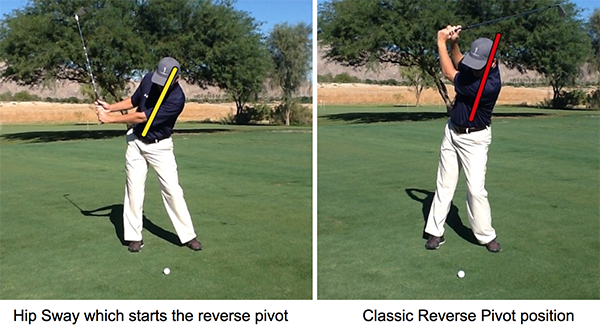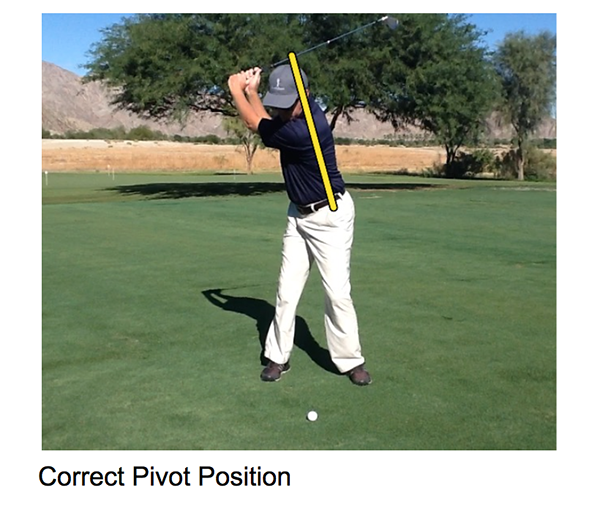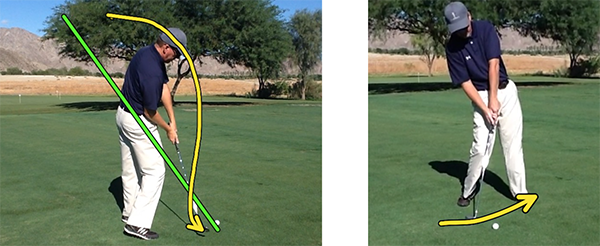Instruction
How to cure golf’s No. 1 swing flaw

If you are a player who is plagued by this swing flaw, then no doubt you’re a tortured golfer who believes there is no cure for your ills. What is this troublesome move? It is called the hip sway, and it’s connected to a term I’m sure you’ve heard before: reverse pivot.
Hip sway is also a well-known term, but many golfers don’t see it and reverse pivot as part of the same fault. Suffice to say, they both cause massive inconsistency and the inability to hit solid shots. A golfer with hip sway may hit a few good drives from time to time, but when it comes to hitting the ball solid off the ground it’s a struggle.
The hip sway/reverse pivot is difficult to cure because when the afflicted player becomes irritated enough to attempt to change their swing, any single modification in the technique won’t affect impact in a positive way. For example, the player could try making a shorter swing, a longer swing, hitting more from the inside, hitting more from the outside, etc., but none of these ideas will work on a consistent basis.
This type of swing flaw will take two ideas or phases to cure it; first fixing the body motion in the backswing and then fixing the downswing and impact. One of my mentors, Jim Hardy, calls this a two-fix, due to the fact you have to fix two things in order for the player’s swing to function properly. It has been my experience over the years that most golfers do not know there is such a thing as a two-phase swing cure.
Sometimes in a lesson, it can be very difficult for a student to hang in there long enough to cure the body motion (pivot) in the backswing and also cure the ball flight. But I assure you, it always works. Once you’ve cured the pivot, you will make progress. The reason this system works is it fixes hip sway, the root of the problem. Once that happens, the player changes categories and moves out of the group of golfers that need two phases to cure their shots. They become part of the group of golfers who need just one adjustment to create better impact and ball flight.
To help golfers cure this problem, I first teach them how to turn properly and not sway their hips. This usually involves working in a mirror so that they can see and feel a correct pivot. If a player is a former baseball player or tennis player, they can be battling an old habit that causes them to shift to their back foot. Once they learn the correct body turn, they are ready to try it on the range, first hitting some shots off a tee. This will build confidence, and once they are turning well and hitting good shots, we can then move to hitting good shots off the grass.
I am very insistent about this process, because if a golfer’s pivot motion does not get cured, the impact and ball flight will not be consistent in the future.
The two photos above show how the downswing and impact are negatively affected by the hip sway/reverse pivot. Notice how the club makes an over-under move on the way to the ball, causing it to be swinging up as it approaches the ball. This up-hit is why these players always struggle with their iron game, but can be somewhat effective off the tee. Notice, also, how the weight is moving toward the back foot, making it nearly impossible to finish with the weight on the front leg.
If you are a player who struggles with hitting solid iron shots and has a variety of misses, then have a friend video your swing and see if you spot a hip sway/reverse pivot. If so, follow this formula and you will be on your way to better iron play and more consistent ball striking.
- LIKE75
- LEGIT11
- WOW3
- LOL6
- IDHT2
- FLOP14
- OB3
- SHANK36
Instruction
Clement: Laid-off or perfect fade? Across-the-line or perfect draw?

Some call the image on the left laid off, but if you are hitting a fade, this could be a perfect backswing for it! Same for across the line for a draw! Stop racking your brain with perceived mistakes and simply match backswing to shot shape!
- LIKE0
- LEGIT0
- WOW0
- LOL0
- IDHT0
- FLOP0
- OB0
- SHANK1
Instruction
The Wedge Guy: The easiest-to-learn golf basic

My golf learning began with this simple fact – if you don’t have a fundamentally sound hold on the golf club, it is practically impossible for your body to execute a fundamentally sound golf swing. I’m still a big believer that the golf swing is much easier to execute if you begin with the proper hold on the club.
As you might imagine, I come into contact with hundreds of golfers of all skill levels. And it is very rare to see a good player with a bad hold on the golf club. There are some exceptions, for sure, but they are very few and very far between, and they typically have beat so many balls with their poor grip that they’ve found a way to work around it.
The reality of biophysics is that the body moves only in certain ways – and the particulars of the way you hold the golf club can totally prevent a sound swing motion that allows the club to release properly through the impact zone. The wonderful thing is that anyone can learn how to put a fundamentally sound hold on the golf club, and you can practice it anywhere your hands are not otherwise engaged, like watching TV or just sitting and relaxing.
Whether you prefer an overlap, interlock or full-finger (not baseball!) grip on the club, the same fundamentals apply. Here are the major grip faults I see most often, in the order of the frequency:
Mis-aligned hands
By this I mean that the palms of the two hands are not parallel to each other. Too many golfers have a weak left hand and strong right, or vice versa. The easiest way to learn how to hold the club with your palms aligned properly is to grip a plain wooden ruler or yardstick. It forces the hands to align properly and shows you how that feels. If you grip and re-grip a yardstick several times, then grip a club, you’ll see that the learning curve is almost immediate.
The position of the grip in the upper/left hand
I also observe many golfers who have the butt of the grip too far into the heel pad of the upper hand (the left hand for right-handed players). It’s amazing how much easier it is to release the club through the ball if even 1/4-1/2″ of the butt is beyond the left heel pad. Try this yourself to see what I mean. Swing the club freely with just your left hand and notice the difference in its release from when you hold it at the end of the grip, versus gripping down even a half inch.
To help you really understand how this works, go to the range and hit shots with your five-iron gripped down a full inch to make the club the same length as your seven-iron. You will probably see an amazing shot shape difference, and likely not see as much distance loss as you would expect.
Too much lower (right) hand on the club
It seems like almost all golfers of 8-10 handicap or higher have the club too far into the palm of the lower hand, because that feels “good” if you are trying to control the path of the clubhead to the ball. But the golf swing is not an effort to hit at the ball – it is a swing of the club. The proper hold on the club has the grip underneath the pad at the base of the fingers. This will likely feel “weak” to you — like you cannot control the club like that. EXACTLY. You should not be trying to control the club with your lower/master hand.
Gripping too tightly
Nearly all golfers hold the club too tightly, which tenses up the forearms and prevents a proper release of the club through impact. In order for the club to move back and through properly, you must feel that the club is controlled by the last three fingers of the upper hand, and the middle two fingers of the lower hand. If you engage your thumbs and forefingers in “holding” the club, the result will almost always be a grip that is too tight. Try this for yourself. Hold the club in your upper hand only, and squeeze firmly with just the last three fingers, with the forefinger and thumb off the club entirely. You have good control, but your forearms are not tense. Then begin to squeeze down with your thumb and forefinger and observe the tensing of the entire forearm. This is the way we are made, so the key to preventing tenseness in the arms is to hold the club very lightly with the “pinchers” — the thumbs and forefingers.
So, those are what I believe are the four fundamentals of a good grip. Anyone can learn them in their home or office very quickly. There is no easier way to improve your ball striking consistency and add distance than giving more attention to the way you hold the golf club.
More from the Wedge Guy
- The Wedge Guy: Golf mastery begins with your wedge game
- The Wedge Guy: Why golf is 20 times harder than brain surgery
- The Wedge Guy: Musings on the golf ball rollback
- LIKE86
- LEGIT13
- WOW6
- LOL1
- IDHT0
- FLOP4
- OB1
- SHANK8
Instruction
Clement: Stop ripping off your swing with this drill!

Not the dreaded headcover under the armpit drill! As if your body is defective and can’t function by itself! Have you seen how incredible the human machine is with all the incredible feats of agility all kinds of athletes are accomplishing? You think your body is so defective (the good Lord is laughing his head off at you) that it needs a headcover tucked under the armpit so you can swing like T-Rex?
- LIKE0
- LEGIT2
- WOW2
- LOL0
- IDHT0
- FLOP0
- OB0
- SHANK2
-

 19th Hole2 weeks ago
19th Hole2 weeks agoDave Portnoy places monstrous outright bet for the 2024 Masters
-

 19th Hole3 days ago
19th Hole3 days agoJustin Thomas on the equipment choice of Scottie Scheffler that he thinks is ‘weird’
-

 19th Hole2 weeks ago
19th Hole2 weeks agoTiger Woods arrives at 2024 Masters equipped with a putter that may surprise you
-

 19th Hole3 days ago
19th Hole3 days ago‘Absolutely crazy’ – Major champ lays into Patrick Cantlay over his decision on final hole of RBC Heritage
-

 19th Hole2 weeks ago
19th Hole2 weeks agoTwo star names reportedly blanked Jon Rahm all week at the Masters
-

 19th Hole1 week ago
19th Hole1 week agoReport: LIV Golf identifies latest star name they hope to sign to breakaway tour
-

 19th Hole1 week ago
19th Hole1 week agoNeal Shipley presser ends in awkward fashion after reporter claims Tiger handed him note on 8th fairway
-

 19th Hole1 week ago
19th Hole1 week agoBrandel Chamblee has ‘no doubt’ who started the McIlroy/LIV rumor and why



















Robert Johansson
Apr 19, 2022 at 3:18 am
This isn’t the cause of the reverse pivot, its due to the golf instruction.
Gurus like Monte cant figure that out
Matt L
Oct 21, 2015 at 3:29 pm
Sways occur because a) people don’t “feel” themselves doing it and b) they don’t know what it feels like to do it correctly.
Get with a good teaching professional that uses video. Look at an example of a good backswing (from your teacher, a tour pro, etc.), work with different “feels” until what you do looks like your good example.
For some reason, I get people that look like stack n’ tilt on steroids as a result of combating a sway.
Tyler
Oct 19, 2015 at 11:26 am
Easy fix is thinking about keeping the right knee pressed inward (for right handed players) in the backswing. That really helped me.
Matt L
Oct 21, 2015 at 3:37 pm
Tyler, the thing about “Swayers” is, they also tend to be “Sliders.” Kicking your right knee in, while possibly being an effective anti-sway messure, could also amp up that slide, resulting in worse issues.
jakeanderson
Oct 18, 2015 at 4:58 am
if you suffer from hipsway like described you need to see a trainer and work on leg and hipstrength and flexibility. the reason for such a hipsway is physical limitation.
Philip
Oct 18, 2015 at 5:36 pm
Or poor setup
Jeff
Oct 17, 2015 at 5:59 pm
Mike,
A video showing this would be helpful. Just saying what to do isn’t all that helpful.
Tanner
Oct 17, 2015 at 6:28 am
Thanks, Mike. You said, at the end to follow this process. But, I didn’t see what the fix was to cure this sway? Turn better, I get it. Any more details? What was your suggestion on the downswing for the hip swayers? Cheers, Tanner
Al385
Oct 20, 2015 at 4:04 pm
I also felt that something was missing here. Two step fix but is just working in a mirror?
marcel
Oct 15, 2015 at 8:46 pm
easy FIX – this 2 steps process will FIX your swing issues. 1. GET A FREAKING GOLF COACH 2. HIT A GYM!!! there is also 3 step – DONT LISTEN TO YOUR BEST PAL WITH NO SWING
Don
Oct 21, 2015 at 12:59 pm
That’s 3 steps, but I agree.
Philip
Oct 15, 2015 at 3:46 pm
But what causes the hip sway in the first place?
Si
Oct 16, 2015 at 4:40 am
People thinking that moving the weight to the trail foot, they can then force that weight to the lead foot, thereby thinking THAT is what is called weight-transfer that helps hit the ball harder and makes it go faster, in their un-athletic body.
Tom
Oct 16, 2015 at 11:26 am
Alcohol.
Todd
Oct 16, 2015 at 12:54 pm
I call it “swing juice”
Tom
Oct 15, 2015 at 2:12 pm
Hey if I’d known you gonna take photo’s of me for this article I would of smiled…